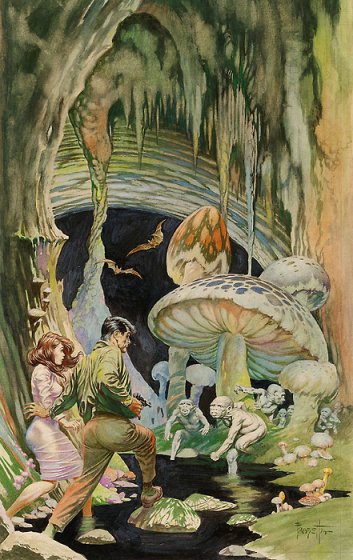 |
| Frank Frazetta |
Subterranean Lumberjacks
On December 26, 1945, there was an explosion in the Belva Mine in Fourmile, KY. What was apparently reported much later (1980-81) was that survivors recounted takes of a "door" opening up in a wall of rock and a man dressed like a "lumberjack" or "telephone lineman" emerging to reassure them they would be rescued. He then disappeared the way be came.
Trapped miners in Shipton, Pennsylvania, experienced similar strangeness. Again survivors reported meeting strange men (similarly clad to the Belva lumberjacks, according to some accounts) who told them they would be rescued and gave them a bluish light and showed them some halographic visuals. The miners seem to have been unclear if their benefactors were fully corporeal. I bet.
Mine Monsters
It could be a lot worse. Just read this pretty likely untrue account that appears on a lot of internet paranormal sites:
PENNSYLVANIA, DIXONVILLE - Mine inspector Glenn E. Berger reported in 1944 to his superiors that the Dixonville mine disaster which "killed" 15 men was not the result of a cave-in, but rather an attack by underground creatures capable of manipulating the earth [partial cave-ins], whose domain the miners had apparently penetrated. Most of the dead miners were not injured by falling rocks but showed signs of large claw marks, others were missing, and one survivor spoke of seeing a vicious humanoid creature that was 'not of this world' within an ancient passage that the miners had broke into. The creature somehow created a "cave-in", blocking himself and another inspector [who closed his eyes when he felt the creatures 'hot breath' on his neck] from the main passage until another rescue party began to dig through the collapse, scaring the "creature" away.Shaverian Mysteries
The monsters don't confine themselves to miners, apparently. The 1967 issue of the Hollow Earth Bulletin prints portion the so-called "The Messerschmidt Manuscript" that proports to give the account of a French woman, who describes her horrifying kidnapping at 19 by deros (or something similar) from an elevator in a building basement in 1943. She and other women endured months of captivity in the hands of monsters than sound a lot like George Pal's morlocks in physical description until they were rescued by pale men in gray, metallic uniforms who slaughtered the beastmen and gave the former captives clothing and medical attention.
44 Cities
It's not all monsters down there, though. An article in the Summer 1978 issue of Pursuit Magazine puts forward a claim by a Dr. Ron Anjard that he knew personally of 44 underground cities in North America. He learned this from anonymous Native American sources. Maybe these relate to the lost cities of the Grand Canyon? Or some of those giant containing tombs?


















